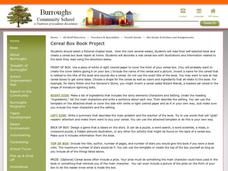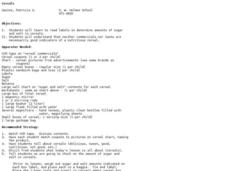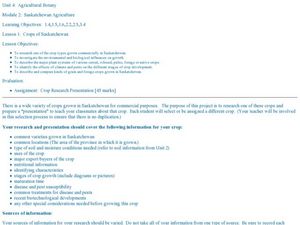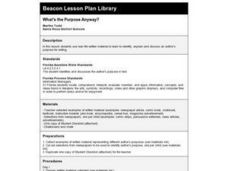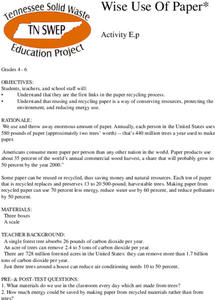Curated OER
Persuasive Writing -- Commercial Style
Students create persuasive TV commercials for common products. They develop a list of products, write the script for a commercial, and act-out and videotape the commercial to present to the class.
Minneapolis Public Schools
Cereal Box Book Project
If you need a new way to approach reading assignments in your class, use a creative cereal box project as a book report. With all necessary templates included for each side of the cereal box, the resource guides readers through the...
Curated OER
Producing Commercials for Videotaping
Students explore television commercials to classify them into categorizes. In this commercial categories lesson, students brainstorm about commercials that catch their attention. Students analyze the categories for commercials and then...
Curated OER
Can You Sell Your Cereal?
Students evaluate television commercials about cereal and create their own cereal product. They watch cereal television commericals and evaluate cereal boxes to compare their features. As a class they create a T-chart to identify words...
Curated OER
Those Convincing Commercials
Second graders study commercials and determine which cereal they feel is the most nutritious.
Curated OER
Cereals
Students watch television commercials, then analyze the nutritional value of the cereals. In this health and nutrition lesson, the teacher shows students several cereal commercials, then the students describe the cereals. Students read...
Curated OER
Marketing to Teens: Introduction
An introductory lesson shows learners how pervasive and influential advertising is in our culture; particularly, how teenagers are actively targeted by advertisers. As teenagers, your students already have all the information they need...
Curated OER
Pop Art Pins & Magnets
Students examine cereal and snack boxes and then create magnets and/or pins using the Pop Art demonstrated in these pieces. This multi-level lesson emphasizes the differences between commercial art examples and fine art examples.
Curated OER
The Breakfast Busters Persuade Others
Students write persuasive essays about their favorite breakfast cereal after seeing how advertisements are used to influence people.
Curated OER
Crops of Saskatchewan
Students research one of the commercial crops grown in Saskatchewan. In this agriculture lesson, students discover locations, characteristics, common problems, and biotechnological developments related to the crops of Saskatchewan.
Curated OER
FAT FOLLIES
Students, testing various foods for fat content by rubbing food samples on paper. Students identify what and who the US Food and Drug Administration is in reference to the Food Pyramid. Students write the name of each food brought in to...
Media Smarts
Looking at Food Advertising
Tony The Tiger, The HoneyComb Kid, The Nestle Quick Bunny. As part of a study of the methods advertisers use to sell foods and how this advertising effects their food choices, kids create their own spokescharacter and/or jingle for one...
Missouri Department of Elementary
Caution: Thin Ice!
Sixth graders listen to a story titled "Thin Ice!" then partake in a whole-class discussion asking and answering questions about what was read. Scholars brainstorm risky behaviors in preparation for a game of RISKO—a game similar to...
Curated OER
Burn Baby Burn
Students use the Internet to research information on the food pyramid, recommended daily allowances of nutrients, caloric intake and expenditure, and value of foods. They analyze their own eating habits and exercise level.
Curated OER
What's the Purpose Anyway?
Examine author's purpose in newspaper articles, comic books, cookbooks, encyclopedias and other forms of written materials. Working in groups, middle and high schoolers read teacher-selected articles and write an explanation of the...
Curated OER
Health Education: Advertising
Fourth graders become conscientious consumers. In this personal health lesson plan, 4th graders analyze techniques used in advertising health-related products and services.
Curated OER
What is a bird?
Students sort birds by their physical characteristics. In this bird characteristics lesson, students review bird characteristics and create beaks. Students discuss birds as pets.
Curated OER
Onomatopoeia Poems
Students write onomatopoeia poems. In this creative writing lesson plan, students listen to a picture book that introduces the concept of onomatopoeia. Students create their own list of words and write a short poem using onomatopoeia.
Curated OER
Why Did You Write That?
Second graders use actual written media to identify and discuss an author's purpose for writing. They identify the author's purpose in a selection from the newspaper, and write a short description of how they came to their conclusion.
Curated OER
Trade Along the Silk Road
High schoolers do a jigsaw activity that will enable them to understand the dynamics of the Silk Road trade. They will break up into smaller groups to discuss an important section of an article. Large groups engage in an activity about...
Curated OER
Wise Use of Paper
Pupils explore the paper recycling process. They experiment with ways to conserve and recycle paper products.
Curated OER
Art-What's it good for?--Absolutely everything!
Students pay attention to details in houses in order to improve observation skills. The skills then are used to help create a three dimensional drawing of a house. Students also examine advertising methods.



